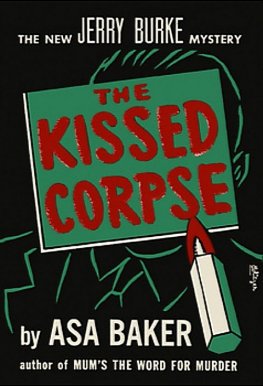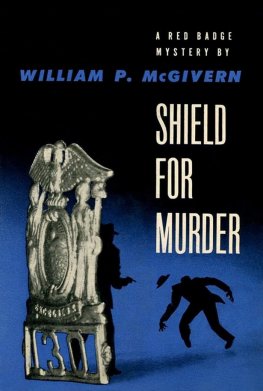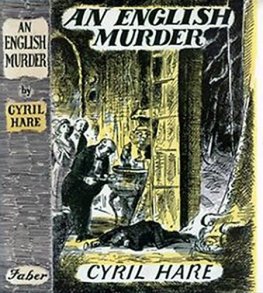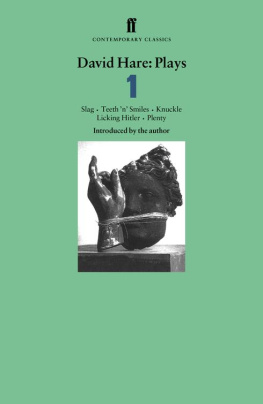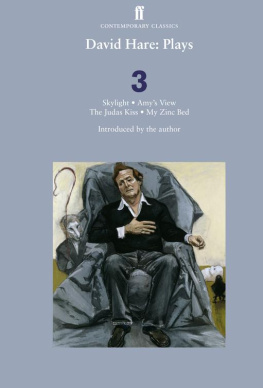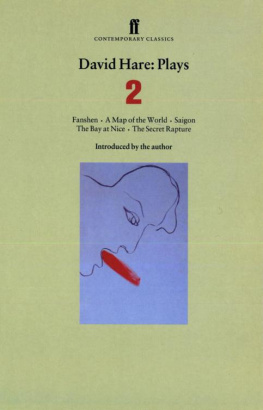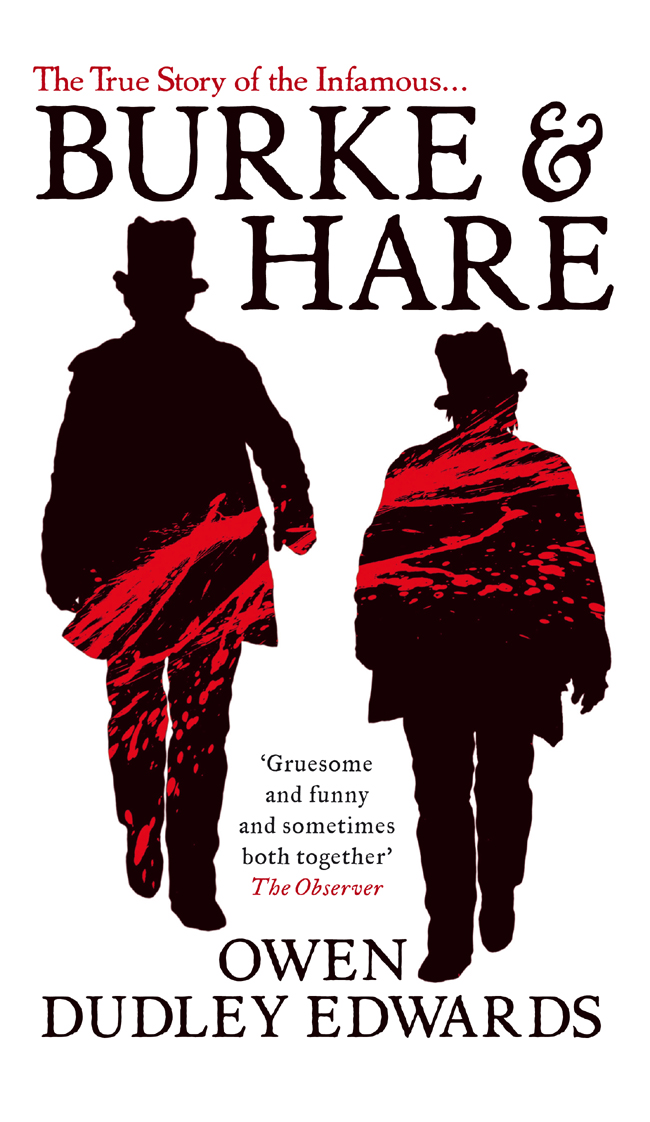BURKE
&
HARE

BURKE, THE MURDERER!
Drawn from life, in the Lock-up House on the day before his execution, by his own consent.

First edition published by Polygon Books in 1980
Second edition published in 1993 by Mercat Press and reprinted in 2010 by Birlinn Ltd
This third edition published in 2014 by
Birlinn Ltd, West Newington House, 10 Newington Road,
Edinburgh EH9 1QS
www.birlinn.co.uk
ISBN: 978 1 78027 217 7
eISBN: 978 0 85790 753 0
Owen Dudley Edwards, 1980, 1993, 2010 and 2014
The right of Owen Dudley Edwards to be identified as the author of this work has been asserted by him in accordance with the Copyright, Design and Patent Act 1988.
All rights reserved. No part of this publication may be reproduced, stored, or transmitted in any form, or by any means, electronic, photocopying, recording or otherwise, without the express written permission of the publishers.
British Library Cataloguing in Publication Data
A catalogue record for this book is available from the British
Library
Typeset in Sabon at Birlinn
Printed and bound by Grafica Veneta
www.graficaveneta.com
To the Memory of the
Edinburgh University Student
Publications Board
Biographical Note
Owen Dudley Edwards FRSE, FRHistS, FSA (Scot.) was initially led to his subjects by something he holds in common with them; he too is an Irish Catholic contributing to higher learning in Edinburgh. Born in Dublin of a distinguished literary family, Owen Dudley Edwards has earned a growing reputation as scholar, author and journalist.
He is Hon. Fellow in History at Edinburgh University, where he taught from 1968. His previous works include Celtic Nationalism; Mind of an Acitivist: James Connolly; 1916 The Easter Rising and P.G. Wodehouse: a Critical and Historical Study. More recently he has written The Quest for Sherlock Holmes: a Biographical Study of Arthur Conan Doyle; Macaulay; Eamon de Valera, and has edited The Fireworks of Oscar Wilde; A Claim of Right for Scotland; and (as general editor) The Oxford Sherlock Holmes (9 vols.). His most recent monograph is British Childrens Fiction in the Second World War, his most recent collaboration (co-edited with Jamie Maxwell) is Why Not? Scotland, Labour and Independence, he contributes a regular column to the Glasgow magazine The Drouth, and writes for the Edinburgh University Journal of Politics and Sociology Scottish Affairs.
Contents
Acknowledgements
I happily reaffirm the many thanks I distributed in the first edition of this book (1980). Alas, many of the recipients are now beyond renewed thanks. I list all persons once more leaving the specificities of their services to the earlier edition. But time can make no difference to my gratitude to: Bruce Young, Robert Sutherland, Margaret Roxton, the late Professor Sir Neil MacCormick, the late Very Rev. Anthony Ross, O.P., Professor Sir Thomas Devine, Professor Bruce Lenman, the late Professor Robert Dudley Edwards and the late Sle Ni Shilleabhin (my parents), Ray Footman, Patrick Rayner, the late Professor Dennis Roberts, the late William Brown, the late Ian Rae, Julian Russell, Alan Bell, Rev. Conrad Pepler, O.P., Dom Mark Dilworth, O.S.B., the late Right Rev. David McRoberts, Nicolas Barker, Professor George Shepperson, Rhodri Jeffreys-Jones, Tom Nairn, the late Robert McIntyre, the late A. G. Donaldson, Griselda Donaldson, Edward Spiers, George Johnstone, Professor Robert Morris, Professor Rosalind Mitchison, William Ferguson, the late John Arnott, the late Allen Wright, Roger Savage, the late Sir John (Lord) Cameron, the late Lionel Daiches, Q.C., David Campbell, Charles Wilde, Paul Harris, Ailfrid Mac Lochlainn, the late Professor David Greene, Ben Shepherd, the late Magnus Magnusson, Professor G. J. Romanes, I. B. Macleod, A. A. Shivas, J. S. K. Stevenson, C. N. Stoddart, Professor Christopher Smout, the late Professor V. G. Kiernan, James Hutcheson, William Kilpatrick Campbell, Louis Appleby, Graham Sutton, Rory Knight Bruce, David Johnston, Timothy Willis, Adam Griffin, Neville Moir, Jamie Donald, Alasdair G. Mathers, Judith Baldwin Mathers, Professor Roy Foster, Bonnie, Leila, Sara and Michael Dudley Edwards. Tom Johnstone, Sen Costello, Allan Boyd and D. Ainslie Thin were invlauable guides in the books second edition by the Mercat Press, later subsumed into Birlinn, for whom Tom saw this latest edition through publication. (The first publishers, Edinburgh University Publications Board, now no more, was a student-run school of journalism to which faculty members, such as myself, were co-opted occasionally; its most famous chair, much beloved for his kindness and idealism, was the future Prime Minister Gordon Brown.) Over the years students and colleagues have improved the books insights and arguments, notably the late Professor Matthew Kaufman of Anatomy at Edinburgh University, and Ms Pat Strong and Dr Jack Cormack of its Royal Medical Society, to whom my cadaver has been bequeathed. My thanks to the National Library of Scotland and to Edinburgh University Library are perpetual.
Introduction
Cest ici, quen dsaccord avec la plupart des biographes, je laisserai MM. Burke et Hare au milieu de leur aurole de gloire.
Marcel Schwob, Vies Imaginaires (1896)
William Burke and William Hare were Ulster Catholics of the agricultural labourer class who came to Scotland around 1818 to work as navvies on the Union Canal. Burke had had previous experience in the Donegal militia. They followed a variety of occupations after the canal had been cut. They met in 1827, when Hare and his recently married wife were running a lodging-house and Burke and his Scottish mistress, Helen MacDougal, came in as lodgers. They became aware of a famine in subjects for the fiercely competing Edinburgh anatomists and each ultimately murdered sixteen persons (fifteen in joint operations) for payment by the famous extramural teacher of anatomy Dr Robert Knox. Their initial involvement seems to have been accidental, and it seems clear that despite folklore neither of them engaged in the business of grave-robbing. Ultimately they separated, Burke and Helen going to their own lodgings, but the murder partnership continued. It finally came to grief when they murdered an old Gaelic-speaking Irishwoman whose original name seems to have been Mary Docherty. Information was given against them by lodgers of Burkes who were also relatives of Helen MacDougal by the name of Gray. Burke and Helen were arrested, the body was recovered the only one to reach the police and the Hares were also taken into custody. The Lord Advocate, Sir William Rae, despaired of a firm case in that Burke and Hare had perfected a method of murder by suffocation which left no clear signs of violent inducement of death upon the corpse. He therefore persuaded the Hares to turn Kings Evidence, and Burke and Helen MacDougal were brought to trial on Christmas Eve, 1828. They obtained the services of the best counsel in Scotland, whose law, very exceptionally for those times, offered prisoners full legal representation and celebrated the tradition of readiness to accept paupers briefs by even the foremost lawyers. Burke was convicted of the murder of Mary Docherty. The murder charge against Helen MacDougal was found not proven. Abortive proceedings were commenced against Hare by the family of one of his victims, but after much urging by Rae, the prosecution was quashed. Hare was smuggled over to England where, some weeks before, Helen MacDougal was also reported to have gone; Margaret Hare got back to her native Ulster. Nothing more is known about any of them. Burke made three public confessions in jail, an official one on 3 January, another in the presence of officials to the Edinburgh


